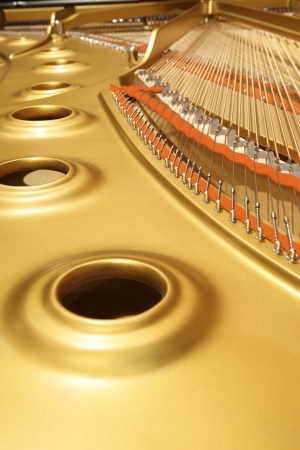Recently I played a gig where, for space purposes, I plugged my keyboard into a small PA system, along with the vocalist. The venue was very small, and there was no need or room for large speakers, and the volume would be low. This small PA did a decent job of making the singer sound good, but the piano sounded terrible. (at least to me) On this gig, it certainly wasn’t worth trying to fix the sound, but it brought up issues I constantly struggle with using a digital piano live.
Over many years, I have searched for (read: obsessed on) the best, most realistic live piano sound using digital gear, since real pianos are not always available or suitable. (Not because I think my playing is better than others, more because I need all the help I can get!) In this quest, I made my own piano sample (You can buy it too!) taking great pains to capture every detail. (read about the process here) While the sound and feel are pretty close, where I still have issues is reproduction through speakers. Let’s look at the factors that seem to interfere with the ultimate simulated piano experience.
Frequency Response
One of the issues that the small PA introduced was that of an uneven and band-limited frequency response. Put simply, a small box can’t move enough air to reproduce the sound of a piano. Midrange and high frequencies are exaggerated, and any bass is resonant and boomy, at best. While a piano doesn’t create much sound above 6 or 7 kHz, it does have lows all the way to the bottom of our hearing range, and any peaks or dips will distort the sound and make it sound “canned.” (I know pianos make sounds all the way to 20 kHz, just not very much… so no snarky comments please!) Worse than a tinny, boxy sound, I found that it went straight from hard-to-hear to ear-piercing with nothing in between. Clearly the small-box speaker isn’t ideal.
Mono vs Stereo
Sometimes people on gigs are surprised that I bring two speakers to relatively quiet gigs. I use these powered PA cabinets if there is room on the stage. The reason is not to be loud, but to move the sound out of the speakers and into the air. I find that I can play much more quietly if the sound is in stereo, and the icepick-in-the-ear effect is much less pronounced. These larger speakers have more lows, so the sound is also subjectively “bigger’ at the same volume.
Directional Pattern
Even with these large, full-range speakers, another issue appears: as PA cabinets, they have horn tweeters, and are designed to “throw” the sound to an audience and not fill the room with sound in all directions. With a 12″ speaker issues of “beaming” are noticeable in the midrange. This is because frequencies with wavelengths smaller than the speaker diameter will become directional. (ask a guitar player about Marshall Stacks) Likewise, when the horn is not pointed directly at me, the sound is muddy, transitioning to piercing when it is. This is because PA speakers are not designed for close-in listening. Most monitor wedges, while not this directional, are not designed to send sound everywhere, since this would make feedback harder to control.
Audience vs. Performer
Another issue with these standard-issue PA cabinets is that if I point them at me, nobody else hears much of anything, and if I point them away, I can’t hear what I’m doing. One compromise is to put them behind me, pointing out, but then another issue arises: the piano sound is coming from behind me! While not a deal-breaker, it’s hardly realistic to play a keyboard instrument with all the sound coming from your back. Plus there is a kind of “null” that occurs when sound comes from 180 degrees behind, causing me to turn up and get clobbered when I turn my head. I guess I could sit with my back to the audience or band, and point the speakers at me… (probably my best side!)
Good Vibrations
When playing an acoustic piano, it’s very easy to feel the keys vibrating under your fingers. While it’s easy to overlook this, it is a big part of the experience, and tells your hands that you are actually producing the sound. Without, the feel is not very “acoustic.” There are various types of tactile transducers out there, but without the solid wooden keys, it may not be possible to create that sensation. (another project for the future)
Bigger Not Louder
Probably the one thing no speaker system has yet to create is the very important aspect of “size” or diffuse sound. A real piano has a large soundboard, many square feet, all vibrating very small amounts. Also, the case and keyboard are also vibrating, and piano manufacturers have various opinions about the case. Steinway uses dense wood, (Beechwood) to reflect sound back to the soundboard, while Bösendorfer uses lightweight spruce for their case, considering it part of the resonant system. In either case, there is a lot of wood vibrating, even for high notes.
When a large soundboard and other components vibrate, they do so in a way that distributes the frequencies to different areas; in other words, when you play a piano note, the various frequencies that comprise that tone are actually coming from different areas of the instrument. They are created by transverse, or bending waves in the wood, of small amplitude, but widely distributed in space. Furthermore, the soundboard is open on both sides, and radiates equally downward and upward.
The result is a complex spatial distribution of the sound, audible from all directions, and filling the room with sound. The lid, when closed reduces some highs, and when open, aims them generally to the right of the pianist. (hence the positioning of the piano on concert stages) However, aside from this, the piano is more or less omnidirectional.
Contrast this with a speaker, which operates using a relatively small cone, with large piston-like motion. It is very difficult to design a speaker that is not somewhat or highly directional, and in most cases, this is desirable, but not for piano.
Concepts
- At first, I thought of using studio monitor speakers in front of me as a personal system for performances; I have seen this done, and it certainly improves the clarity of the sound for the player. There are some issues: This doesn’t help the band or the audience, so a second set of speakers will be needed if there are not stage monitors. Also, they are small, point-sources, so they wouldn’t create the diffuse, broad sound needed. And they wouldn’t be big enough for the bass frequencies.
- Another idea: build some speakers that face both ways, with cones facing both directions, possibly like vertical posts. First, this kind of speaker would be complex to build, and they would still be line-array or piston speakers.
- I thought of building a piano-like case with upward and downward facing speakers. Besides making the keyboard very heavy, this seems like a good idea, since it would also vibrate the keys and send the sound up and down, like a piano, though the design would be complex.
Flat Panel
The best idea I can find right now is to attempt to build a flat-panel, distributed-mode speaker. This is a relatively new area, and involves a lightweight panel in a frame, set in motion by transducers called exciters. These devices are like speakers without cones, and transfer their motion to the panel, which moves much like a soundboard. There has been much research and experimentation in this area, and they are surprisingly simple to build. The only issue is that it takes a fairly large panel to create useful low-frequency sound. (much like a real piano!)
My current plan is to put together a couple of these and stand them in front of the keyboard. They are by nature omnidirectional, and would thus function as both monitor and reinforcement. As far as whether they would sound good vertically rather than horizontally, we shall see. (upright pianos seem to work OK)
Links:
A looooong thread about flat-panel design. (the guy who started the thread actually died during the hundreds of pages. 🙁
An interesting PDF about building flat-panels
Podium Sound flat panel speakers. (I would buy these and use them, but they are expensive and huge)


